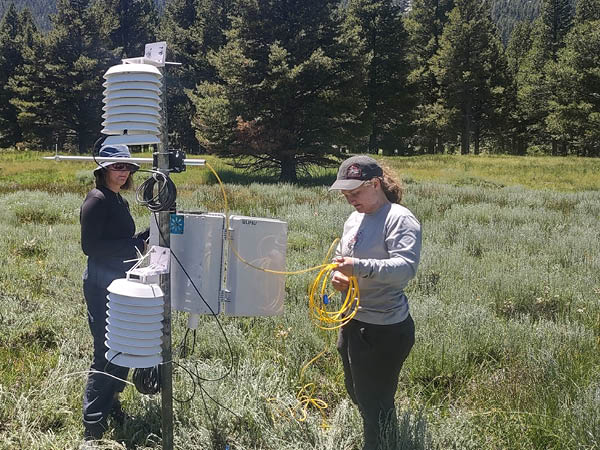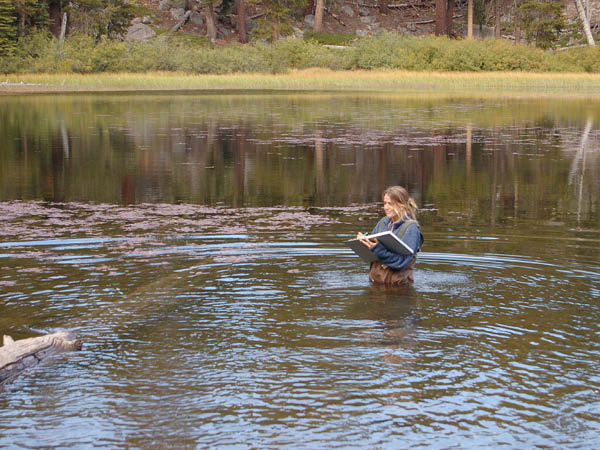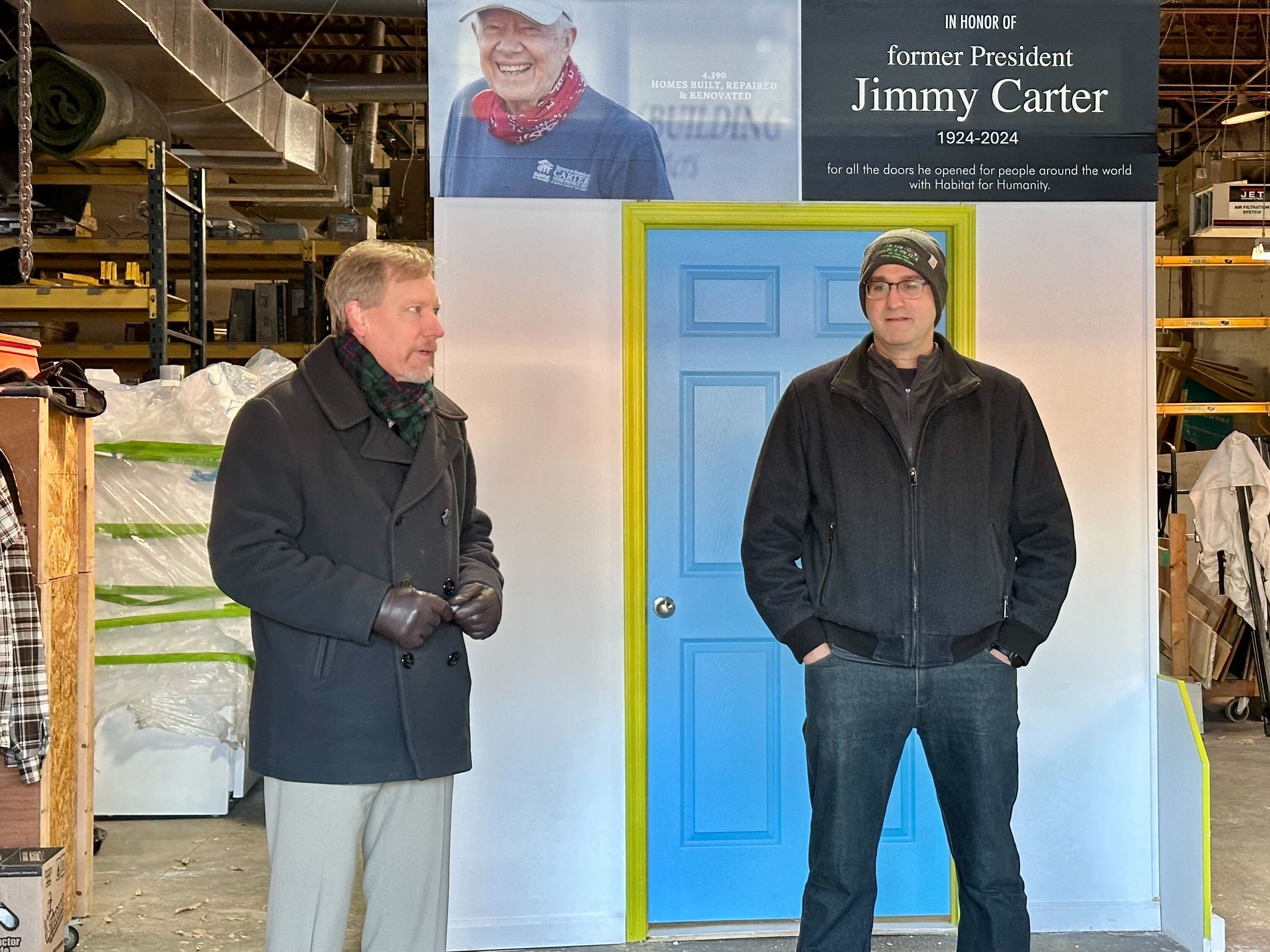Nevada
Tahoe Environmental Observatory Network looks beyond the lake | University of Nevada, Reno

The University of Nevada, Reno, in collaboration with the U.S. Forest Service Pacific Southwest Research Station and the Tahoe Science Advisory Council, is launching the Tahoe Environmental Observatory Network (TEON), a new initiative to better understand the health of the Lake Tahoe watersheds and ecosystems, and make collected data accessible to everyone.
Sudeep Chandra, director of the University of Nevada, Reno’s Global Water Center and Ozmen Institute for Global Studies, and Gina Tarbell, research ecologist with the U.S. Forest Service at the Pacific Southwest Research Station, have been on the project since its inception and are excited about its holistic nature. Both are members of the Tahoe Science Advisory Council.
“A lot of the focus in the past has been on the lake and water quality,” Tarbell said. “In this project, we’re trying to zoom out and look at the forest and how changes to the forest can affect the lake and the watershed of Tahoe altogether.”
This new project looks beyond the lake’s basin to the streams, rivers, wildlife, weather and runoff that impact the lake, giving researchers and policymakers a more complete picture of how to best protect the lake, its famed clarity and its natural ecosystems. To accomplish this, TEON is setting up a grid of data-capturing systems around the lake, creating a network of sensors that update regularly with live information. With this data, researchers can assess conditions and changes in real-time across the covered area, an important tool in understating the health of Lake Tahoe.
“In this network, we use not only high-tech tools that can sense the environment every hour, every minute within the system, but we also make direct observation of ecosystems that have been measured in the past,” Chandra said. “The Tahoe Environmental Observatory Network builds upon previous research projects and monitoring programs. In the past, we established research programs that characterize a baseline of understanding of the watershed down to the lake and lake conditions, over short- and long-term periods. What we’re trying to do now is put in high-frequency sensors to understand environmental change within the systems. For example, we’re putting in game cameras to track when wildlife is present in certain regions. We’re putting in sensors in the water that allow us to understand oxygen and temperature in real-time conditions during different climatic events.”

The network is one of the first of its kind in the area, with sensors collecting wildlife, geographic, watershed and environmental data, allowing for an overarching understanding of lake changes in the past, present and future. To get the most accurate picture of lake conditions, Tarbell’s team is also working to set up sensors that capture effects from urbanization.
“What we are trying to do is set up a monitoring system that can look at the entire basin as a whole,” Tarbell states. “This is difficult because the Tahoe Basin is really different depending on what side of the lake you’re on or what elevation you’re at. We’re trying to create a system that is representative of all these different parts of Tahoe. To do that, we have to set up a grid across many different habitats while also thinking about the sub watersheds, which also need to be represented, because they differ depending on how much urbanization there is or what kind of habitats they are in. Those factors have impacts on water quality and the lake as a whole.”
As data streams in from TEON, researchers will be able to make the most timely and accurate assessments of current conditions in the Lake Tahoe Basin and compare it to data sets from the past to understand implications for the future. Already, with initial data, scientists like Tarbell and Chandra have confirmed past research showing ecosystem changes, including a diminishing old-growth forest, fluctuating water temperatures and inconsistent loads of nutrients in the water, potentially affected by climate change and general urbanization of the basin. The development of TEON is contributing to a pool of current data that could help predict future changes, allowing scientists and policymakers to address issues before they affect Lake Tahoe.
A Successful Collaboration
Unique to the project is its basin-wide multi-organizational collaboration. The group is notably interdisciplinary, with partners including the U.S. Forest Service Lake Tahoe Basin Management Unit, California Tahoe Conservancy, Tahoe Regional Planning Agency, Nevada Division of State Lands, California State Parks, Tahoe Institute for Natural Sciences, Tahoe Fire and Fuels Team, Biologist Interagency Group and the Tahoe Fund. The organizations’ interest in the data network range from using it for scientific study, for enhancing climate adaptation and for policy creation in the Lake Tahoe Basin.
“The University of Nevada, Reno at Lake Tahoe is a strategic partner in implementing the Tahoe Environmental Observatory Network,” Chandra said. “We utilize the campus along with our collaborations with the U.S. Forest Service Pacific Southwest Research Station as our home base, and we’re trying to implement this program right here in Tahoe so it can be utilized as a model for understanding environmental change in other ecosystems.”

This collaborative project is a multi-organizational approach to understanding and preparing for climate changes in the Lake Tahoe Basin. The impetus to create this network stemmed from a need for interdisciplinary partnership, which is crucial in caring for the ecosystem of the lake while also protecting its economies and cultures. With these groups working together, the network can focus on questions important to climate change mitigation efforts.
“We live in a dynamic world,” Chandra stated. “We have shifting climate, the introduction of species in the lake, wildfires that come through. Our goals are to try to understand and link how these extreme events would change forest structure, animal behavior and eventually the water quality in the lake. We expect to learn about the resilience of Lake Tahoe and the streams and watersheds when there are these environmental perturbations. We are asking questions like when do these changes last for a long time? Or maybe when do we see immediate recovery?”
Most unique to this program is that the data collected will be open for public use on a user-friendly website. Avid birders, for example, other scientists, policymakers and interested community members will be encouraged to use this as a resource for planning and to spark curiosity about the Lake Tahoe ecosystem.
“We plan to put everything in a database that is available online,” Tarbell said. “The general public, scientists, researchers and managers in the basin and other areas can access that data and use it to inform their own research or management decisions. For example, we’re going to be taking wildlife photos at camera stations and recording birdsong so that we can identify the bird community in the area.”
For those who have been connected to the lake their whole lives, to communities who depend on it as a resource, and for those who have found their connection to nature by spending time outside, the protection of Lake Tahoe is imperative. TEON serves as an example of innovation in scientific data collection and successful interdisciplinary collaboration between The University of Nevada, Reno, U.S. Forest Service Pacific Southwest Research Station and partners within the Tahoe Science Advisory Council. The hope is that this project can mitigate the harmful effects of climate change before they occur.
“I think understanding the effects of climate change is the most important thing we can do right now,” Tarbell said. “We need to know what has happened and be able to better predict what will happen so that we can ensure that we have these forests and this beautiful lake forever.”

Nevada
Nevada fuel line will return to normal service

LAS VEGAS, Nev. (FOX5) – Clark County asks consumers to ”not panic buy at the pump.”
After messages from Clark County saying the fires in California were potentially affecting the fuel lines servicing Southern Nevada, the County is advising the public to not run out and buy gas for their cars.
The gas line from California to Nevada will re-start and be operational by Friday.
Message from Clark County:
“In working with California, a solution has been put in place which will power the Kinder Morgan fuel line into southern Nevada and fuel should start to flow into the valley in the next 12-24 hours. Clark County Office of Emergency Management remains engaged on this issue with regional and state partners. The public is encouraged to not panic buy at the pump.”
FOX5 will have a full report on the gas line running from California to Nevada at 10 and 11 p.m.
Copyright 2025 KVVU. All rights reserved.
Nevada
Missing Southfield girl might be in Nevada with man who just found out he’s her father, police say

SOUTHFIELD, Mich. – A 4-year-old Southfield girl who has been missing for two months might be in Nevada with a man who just found out he’s her father, police said.
Bali Packer was picked up by her biological father, Juwon Madison, on Nov. 10, 2024, and has not been returned to her mother, Timeah Wright-Smith.
Packer was last seen wearing a blue PJ mask shirt, pink hat, pink leggings, and pink boots.
Madison is not listed on Packer’s birth certificate, and no court order in place states he has any parenting time.
He recently discovered that he may have been the father of Packer prior to picking her up with her mother’s permission, who is the sole guardian of the 4-year-old girl.
Madison is believed to have left Michigan and went down to Nevada.
Wright-Smith does not believe Packer is in any danger.
| Bali Packer | Details |
|---|---|
| Eyes | Brown |
| Age | 4 |
| Height | 3′3″ |
| Hair | Brown |
| Weight | 3 pounds |
Anyone with information should contact the Southfield Police Department at 248-796-550 or Crime Stoppers at 1-800-Speak Up.
All tips to Crime Stoppers are anonymous. Click here to submit a tip online.
READ: More Missing in Michigan coverage
Copyright 2021 by WDIV ClickOnDetroit – All rights reserved.
Nevada
Southern Nevada’s desert tortoises getting help to cross the road

Long before Southern Nevada built its winding highways, desert tortoises roamed freely without consequence. For these federally protected animals, crossing the street without a dedicated path could mean a death sentence.
Along a 34-mile stretch of U.S. Highway 93 near Coyote Springs, fencing and underground tortoise crossings will allow for more safe passage.
“We see substantial road mortality and near-misses in this area,” said Kristi Holcomb, Southern Nevada biological supervisor at the Nevada Department of Transportation. “By adding the fencing, we’ll be able to stop the bleed.”
The federal Department of Transportation awarded Nevada’s transportation agency a $16.8 million grant to build 61 wildlife crossings and 68 miles of fencing along the highway. Clark and Lincoln counties, as well as private companies such as the Coyote Springs Investment group, will fund the project in total.
Under the Endangered Species Act, the federal government listed Mojave desert tortoises as threatened in 1990. The project area includes the last unfenced portion of what the U.S. Fish and Wildlife Service considers to be the desert tortoise’s “critical habitat.”
In Clark County, some keep desert tortoises as pets, adoptions for which are only authorized through one Nevada nonprofit, the Tortoise Group. Environmentalists in the area have long worried that sprawling solar projects may have an adverse effect on tortoise populations. As many as 1,000 tortoises per square mile inhabited the Mojave Desert before urban development, according to the Center for Biological Diversity.
Crossings prevent inbreeding
One major reason that connecting critical habitat across a highway is paramount is to prevent inbreeding, Holcomb said.
“When you build a highway down the middle of a desert tortoise population, they become shy about crossing the highway,” Holcomb said. “By installing tortoise fences, we’ll give the tortoise population a chance to recover.”
Desert tortoises tend to walk parallel to the fences, which will lead them to the crossings they need to go to the other side. Promoting genetic diversity is one way different tortoise populations can be stabilized, Holcomb said.
The Nevada Department of Transportation doesn’t have a set timeline, and the project will need to go through an expedited federal review process to ensure full consideration of environmental effects.
“Be mindful, not only of tortoises that might be on the roadway, but also of our impacts on tortoises,” Holcomb added.
Contact Alan Halaly at ahalaly@reviewjournal.com. Follow @AlanHalaly on X.
-

 Business1 week ago
Business1 week agoThese are the top 7 issues facing the struggling restaurant industry in 2025
-

 Culture1 week ago
Culture1 week agoThe 25 worst losses in college football history, including Baylor’s 2024 entry at Colorado
-

 Sports1 week ago
Sports1 week agoThe top out-of-contract players available as free transfers: Kimmich, De Bruyne, Van Dijk…
-

 Politics1 week ago
Politics1 week agoNew Orleans attacker had 'remote detonator' for explosives in French Quarter, Biden says
-

 Politics7 days ago
Politics7 days agoCarter's judicial picks reshaped the federal bench across the country
-

 Politics5 days ago
Politics5 days agoWho Are the Recipients of the Presidential Medal of Freedom?
-

 Health4 days ago
Health4 days agoOzempic ‘microdosing’ is the new weight-loss trend: Should you try it?
-

 World1 week ago
World1 week agoIvory Coast says French troops to leave country after decades















